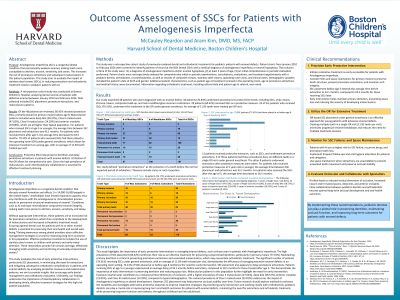Preventive
426 - Outcome Assessment of SSCs for Patients with Amelogenesis Imperfecta


McCauley Reardon (she/her/hers)
DMD Candidate
Harvard School of Dental Medicine
Harvard School of Dental Medicine
Brookline, MA, Massachusetts, United States
Aram Kim, DMD,MS,FACP (she/her/hers)
Prosthodontist
Boston Children's Hospital
Harvard School of Dental Medicine
Chicago, Illinois, United States
Aram Kim, DMD,MS,FACP (she/her/hers)
Prosthodontist
Boston Children's Hospital
Harvard School of Dental Medicine
Chicago, Illinois, United States
Presenting Author(s)
Co-Author(s)
Program Director(s)
Purpose: Amelogenesis Imperfecta is a congenital dental condition that permanently weakens enamel, making teeth more susceptible to attrition, erosion, sensitivity, and caries. This increases the risk of premature extractions and subsequent malocclusions in this patient population. This study aims to evaluate the impact of stainless steel crowns (SSCs), in reducing extractions and orthodontic treatment needs in pediatric patients with AI.
Methods: A retrospective cohort study was conducted at Boston Children’s Hospital, analyzing dental records of patients with defective enamel between January 2010 and February 2024. Data collected included SSC placement, premature extractions, and malocclusion patterns.
Results: Of the 48 patients we reviewed, 60.42% received protective SSCs, primarily placed on primary molars before age 8. Malocclusion patterns included were deep bite (28.57%), Class II malocclusion (47.62%), Class III malocclusion (14.29%) and anterior crossbite (19.05%), which are all higher than typical population. For patients who received SSCs at age 5 or younger, the average time between SSC placement and extractions was 43.1 months. For patients who received them after age 5, the average time decreased to 18.5 months. 79.31% of patients who received SSCs had them placed in the operating room (OR) under general anesthesia, which allows for extensive treatment at a young age, with an average of 11.83 teeth treated per visit.
Conclusions: Protective SSCs help preserve dentition and delay premature extractions in patients with enamel defects. Utilization of the OR allows for comprehensive care. Given the high prevalence of malocclusion, early interdisciplinary collaboration is essential for effective treatment planning.
Identify Supporting Agency and Grant Number:

.jpg)